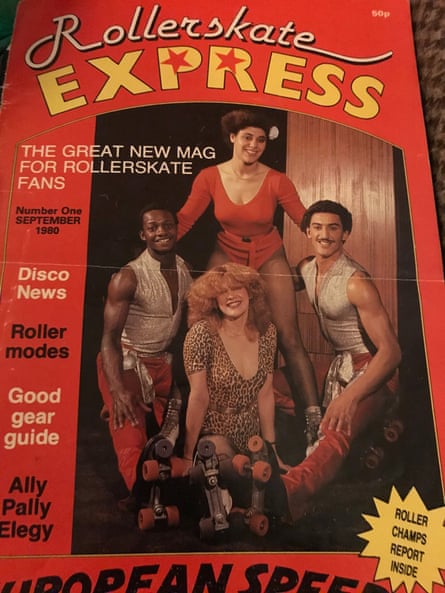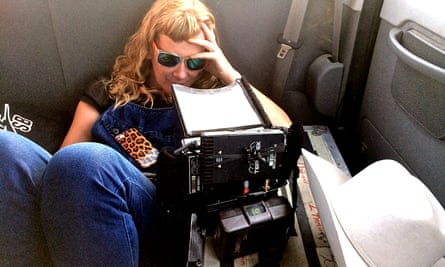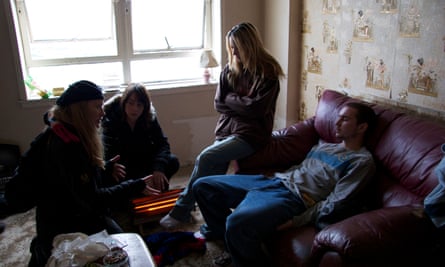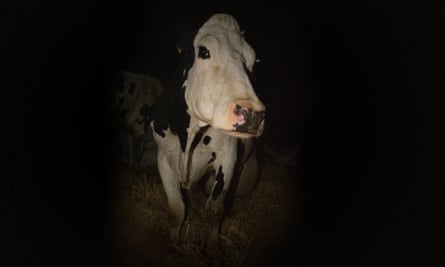Andrea Arnold’s films are known for their spare dialogue, and in her first documentary it is more pared-backed than ever: Cow consists of 94 minutes of moos, with the odd off-camera interjection from farmhands. It is hardly a thriller (though the ending is pure Tarantino). But it is one of the most beautifully crafted and tender portraits of a life you are likely to see.
Arnold, who started her professional life as a rollerskating TV presenter on the children’s Saturday show No 73, began thinking about documenting an animal’s life nine years ago. Eventually she settled on a cow. “I thought a cow would be interesting because they work so hard, getting pregnant and giving milk their entire lives. It’s a huge job they do.” She chose Luma because she was told she had a big personality and was feisty. Arnold and her team spent four years, on and off, filming her. Why did she make Cow? “I wanted to show a non-human consciousness. I was intrigued as to whether we would be able to see her consciousness if we followed her long enough.”
Her friends have told her Cow is the most personal film she has made. “One friend said there was nowhere for me to hide in a documentary; it was more raw and I was more exposed, she said.” But what is she exposing? “Well, things to do with my childhood, I suppose. But I don’t talk about all that because it’s too complicated. It’s extremely messy, so I can’t really.”
We meet at a cafe in south London, where she has has lived for 27 years. Arnold is a youthful 60, dressed in jeans, beret, and a fake fur coat “made of real teddy bear”. She is warm and engaging but fiendishly private. She admits to having a 27-year-old daughter, and being one of four children brought up by a single mother, but declines to answer most questions about family. However, she does it with such charm that the sparring becomes enjoyable. Bits and pieces gradually emerge, from which we can piece together a partial jigsaw.
Her films are like this, too: composed of fragments, open to different interpretations. In the autobiographical Wasp, which won the Oscar for best live action short in 2004, a single mother of four is asked out for the first time in years. She pretends she is looking after the kids for a friend and leaves them outside the pub to play without telling her date, which results in all kinds of chaos.
Arnold’s narratives are rarely linear and usually elliptical, leaving us to fill in the missing details. In her first full-length work, Red Road, we only begin to understand towards the end of the film why protagonist Jackie has been stalking a newly released prisoner. After it finishes, we find ourselves rewinding the film in our head, reinterpreting all that has gone before – or simply watching it again.
Astonishingly, three of her four movies – Red Road, Fish Tank and American Honey – have won the Jury prize at the Cannes film festival. In Fish Tank, which tells the story of a 15-year-old girl finding her way in the world, there is no mention of her absent father because he’s an irrelevance. In American Honey, a road movie about a group of disadvantaged youngsters crossing America and trying to get by flogging magazines, she pretty much does away with backstory. As for her Heathcliff in Wuthering Heights, he barely utters a word – it’s all about the unspoken emotion. Arnold is a wonderful film-maker. Her movies are beautifully written (or under-written), nuanced and gorgeous to look at, even when the world they depict is brutal. They are often unbearably tense, her characters invariably living on the brink of violence or betrayal.
Although Cow is a documentary, it still feels very much like an Arnold film. It starts with Luma giving birth. In a lovely extended scene she licks her baby clean of amniotic fluid and the calf starts suckling. Luma really is luminous in the pitch-black cowshed – stills from the film look like bovine Rembrandts. While Cow never anthropomorphises Luma, it does allow us to see the world from her perspective. It’s impossible to watch without imagining what is going on in her head.

There are recurrent themes in Arnold’s films – single mums and struggling children, chaotic lives, sexual and commercial exploitation. Cow fits perfectly into this pattern. Luma is the ultimate single mother, constantly pregnant, separated from her children, milked for all she is worth. Arnold’s work could easily be a misery-fest, but it isn’t because she is also alert to all that’s good in life – the intensity of youth, the first flushes of love and lust, dancing yourself to oblivion, the power of resilience. Her characters may not thrive but they are survivors. Again, Cow is consistent with that vision. We experience the purity of the mother-child bond in the first few hours after birth, the joy of the cows at spring turnout when they are let loose in the fields, the literal and metaphorical fireworks as cattle mate on Bonfire Night. As in all her work, music plays a large part. Some songs are piped into the cowsheds from Radio 1 to keep cattle and farmhands happy; others are handpicked by Arnold.
Although animals are not the subject of her other films, they feature prominently. In Red Road, Jackie, who works as a CCTV security camera operator, frequently zooms in on a man with a dog – without saying a word, Arnold conveys Jackie’s sense of longing. In Fish Tank, 15-year-old Mia suffers so much trauma in silence, and it’s only when she hears her friend’s horse has been put down that she cries. And Arnold’s short Dog features one of cinema’s most disturbing animal scenes. A teenage girl and boy are having sex. As usual, we witness the scene from the girl’s perspective. While the boy thrusts away, the girl sees a dog steal his stash of dope and eat it. She laughs – at what she has just witnessed, not the boy. But the boy feels humiliated and takes a terrible revenge on the dog.

Animals have played a huge part in Arnold’s life. When she was young, the family home on a low-rise estate in Dartford, Kent, was full of waifs and strays – numerous cats and dogs, guinea pigs and gerbils, and a sheep who lived in the garden but would wander in for the occasional chat. “I remember Mum going absolutely mad when we got back with the lamb.” Her mother, who was only 16 when Arnold was born, died a couple of years ago. Were they close? “I’m not going to talk about it,” she says in a sing-song voice.
Fish Tank is about the troubled and competitive relationship between Mia (an aspiring dancer, as Arnold was) and her mother. They even compete over her mother’s boyfriend Conor, played with a chilling brilliance by Michael Fassbender. At times Mia is ferocious (she headbutts a fellow schoolgirl without compunction, and abducts Conor’s daughter in a terrifying scene) yet we are always aware of her vulnerability.
I ask Arnold if she could headbutt her way out of trouble as a teenager. She laughs. No, she says – she has never had a scrap in her life. “But I’ve stopped fights. I can probably count 20 fights I’ve stopped in the last few years. I’m very good at reading that kind of situation and I’m not frightened of it. It’s probably why I’m a film-maker. I’m vigilant and able to read people. I’ve got some skills from my childhood that have served me well as a film-maker.” Did she stop fights as a kid? “I tried to sometimes. But that’s difficult to talk about because; that’s a lot to do with my …” She trails off. “I can’t talk about this stuff. It involves too many people.”
So instead she tells me how she stopped a fight in a pub in Essex. “One of the blokes had the guy on the ground and was kicking his head against the gutter. And everyone was just watching. The guy who was kicking him suddenly got tired, stopped and was panting and I saw there was a moment to get in there. Also because I’m a female I feel they’re not going to turn on me.” She pauses. “Though I have stopped fights and they have turned on me. I stopped a boy hitting his girlfriend. He was punching her in the street and nobody was doing anything and I got in between them. The girl ran away, and he just went mad at me. He got hold of my hair, pushed me on the ground and spat at me. Then my friend had to try to get him off me.”

What makes her intervene? “I can’t bear seeing people being cruel or violent to other people.” Has she always been fearless? “I’ve always been fearless, but I’m not tough.” She thinks about what she’s just said. “Actually fearlessness is a kind of toughness.”
The young Arnold was a bright girl, who rarely got the opportunity to excel. She left her comprehensive school at 16 to take up hairdressing, hated it, and returned to the sixth form. At 18, she auditioned to be a presenter for No 73, and got the job. She looked so cool – rollerskating, glamorous, carefree – but she says she was always uncomfortable in front of the camera. “I think I look terrified. It was live so it was terrifying. Everyone I was with had done some training and I hadn’t done any whatsoever.” After seven years, when No 73 finished, she decided to reinvent herself as a director. She realised she could turn the stories she had been writing into films. Arnold disappeared from view and has rarely been seen on TV again. She was so determined to make a new start that she swapped continents to retrain at the American Film Institute of Los Angeles.
In 1998, she made her first short film, Milk, about a traumatised woman who has given birth to a stillborn baby and addresses her grief by having sex with a man young enough to be her son, who ensures her breast milk doesn’t go to waste. Whatever Arnold’s protagonists have been through, they are never simple victims; they still have “lots of lights on” as she says. The same can be said of Luma. She has endured the toughest of lives, but there is never any sense of her giving up. Towards the end of the film, her udder ligaments have ruptures, she can barely be milked, and she drags her teats painfully along the floor. But, Arnold says, the more she struggled, the more stoic she became. “I sensed this huge sense of service for us. She was still doing this thing she’s been taught to do.”

The longer she spent with Luma the more she was able to read her moo music. As the animal got older, and was separated from more calves, she also seemed to become angrier, Arnold says. She is convinced Luma felt compassion for the other pregnant cows, aware of what they were about to lose. “They say the difference between humans and animals is that we can see the past and think about the future, but I could see Luma knew what’s coming when she’s pregnant. She got particularly mad when she saw the farmer taking away a calf from another cow.”
Every time she does a Q&A with an audience about Cow, Arnold is amazed by the response. “We had a screening at the London film festival. People were crying, one person fainted, somebody was sick, somebody had a panic attack. Somebody said to me it made them think women’s bodies are not their own; somebody said ‘It makes me think of infertility and how hard I’ve tried for a baby’; somebody said ‘It’s made me feel about my mother and the relationship we’ve never had’; somebody talked about the relationship with a mother she did have, and somebody said it made them think about how our lives are managed.”
As for Arnold, more than anything Cow has made her think of the importance of being seen. “I kept saying involuntarily during the edit: ‘I’m seeing you, Luma. Don’t worry Luma, we see you.’ I’m not sure any farm animal really feels seen. And I wondered what that meant in terms of her existence.”
Has making the film changed her? “Every film changes me. I take a long time making every film, and each one is like a massive growth for me.” She returns to the idea of being seen. “I wonder how much we see not just other animals but each other. Do we really take on board each other and listen and react to people – our families, our friends, our partners, the person on the street?” She knows she’s just made a film about a cow, but to her it feels more elemental. “It’s made me feel a lot about how we’re all connected. I think all living things feel the kindness or cruelty of other living things, so all the decisions we make about how we behave with animals, with plants, with somebody getting on the bus, are so important.”

Comments (…)
Sign in or create your Guardian account to join the discussion